What's New
Displaying results 3561 - 3570 of 4052
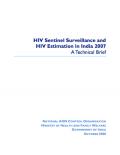
Resource | Publications,
HIV Sentinel Surveillance is an annual exercise conducted to monitor the trends and levels of HIV epidemic among different population groups in the country. It is implemented with the support of two national institutes and five regional public health institutes of India. The methodology adopted is Consecutive Sampling at the service facilities and Unlinked Anonymous Testing after removing all the identifiers.
HIV Sentinel Surveillance 2007 was conducted at 1134 sentinel sites – 646 sites among the general population and 488 sites among the high-risk group population (FSW, MSM, IDU, migrants, and truckers). A total of 3,58,797 samples were tested during HIV Sentinel Surveillance 2007.
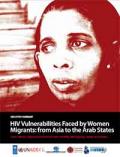
Resource | Publications,
The Arab States are the primary destinations for many migrant workers from various countries in Asia, including Bangladesh, Pakistan, the Philippines, and Sri Lanka. Of these migrants, many are women: in 2005, 59 percent of Sri Lankan migrant workers were women, of which 90 percent were domestic workers, largely in the Arab States. Since 2000, women have comprised 90 percent of yearly deployment of new hires for service workers in the Philippines, of which 30 percent are employed as domestic help. A similar preference for the Arab States is observed in the case of Bangladesh, where between 1991 and 2007, 60 percent of female migrants left to find employment in the Arab States.
By analyzing the economic, socio-cultural, and political factors that influence the HIV vulnerability of migrant workers - especially female migrant workers - the study aims to aid the design of appropriate rights-based HIV prevention programmes. It also is intended to identify emerging challenges and trends in the response to HIV and migration issues in host countries, particularly in the area of human rights and public health.
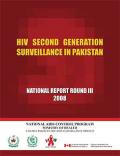
Resource | Publications,
This report provides biological and behavioural information of HIV related high-risk groups (HRGs) from the 3rd round of surveillance, conducted from March to June 2008 in Pakistan. The study was a cross-sectional behavioral and biological survey of three HRGs including Injecting Drug Users (IDUs), Male Sex Workers (MSWs), and Hijra Sex Workers (HSWs).
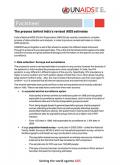
Resource | Fact Sheets,
India’s National AIDS Control Organization (NACO) has recently completed a complex process of data collection and analysis, in order to produce revised estimates on India’s AIDS epidemic.
UNAIDS has put together a set of fact sheets to explain the different steps India went through to produce the revised estimates. This is the first fact sheet which explains the data collection process and gives additional background information on the specific surveys and surveillance.
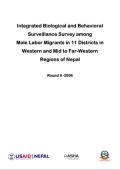
Resource | Publications,
This is the second round of the Integrated Biological and Behavioral Surveillance Survey (IBBS) conducted among 360 migrant workers in five districts of the Western development region and another 360 migrants of the Mid to Far Western development regions. The field survey was carried out during the months of June to September 2008. The survey measured HIV and STI prevalence among migrant workers, as well as condom use, sexual behaviors, knowledge of HIV/AIDS and exposure to HIV/AIDS messages, cases of sexually transmitted infection (STIs), STI treatment behaviors, and drug habits.

Resource | Publications,
The Lao PDR Multiple Indicator Survey is a nationally representative sample survey which was conducted between March and June 2006. In the 5,894 households successfully interviewed nationally in the survey, 33,100 household members were listed. Of these, 16,467 were males and 16,633 were females. The average household size found in the survey was 5.6.
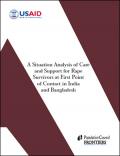
Resource | Publications,
Many times, paperwork and these administrative obligations delay rape survivors' access to some RH services, such as emergency contraception pills (ECP) or post exposure prophylaxis (PEP), because many of these services have small windows of time (72 hours) in which they can be administered effectively. Unless health service staff are aware and able, many of these women may miss their opportunity to obtain certain RH and HIVforms of care.
To evaluate the current environment, a situation analysis of post-rape care services available at the first point of contact was conducted. The aim of this investigation was to gather information that could be used in the development of a comprehensive care and support system for the rape survivor. Secondarily, the study field-tested sensitive and practical tools that could be used in the future for large-scale situation analyses of the rape survivor services. This study was carried out in three cities in India (Delhi, Lucknow, and Vadodara) and four cities in Bangladesh (Dhaka, Chittagong, Sylhet and Tangail).
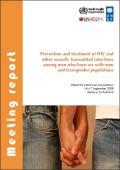
Resource | Publications,
There is an urgent need to address the emerging and re-emerging epidemics of HIV and other sexually transmitted infections (STIs) among men who have sex with men (MSM) and transgender people. Strengthening strategic information systems and implementing interventions for the prevention and treatment of HIV and other STIs among MSM and transgender people should be considered a priority for all countries and regions as part of a comprehensive effort to ensure universal access to HIV prevention, care and treatment.
A meeting held on 15–17 September 2008 in Geneva brought together participants from the World Health Organization (WHO) and its United Nations (UN) partners along with representatives from 26 countries to discuss the role that the health sector can and should play in addressing prevention, treatment and care of HIV and other STIs among MSM, transgender people and their sexual partners.

Resource | Publications,
Outline:
- The essential criteria for a National Strategic Plan
- The importance of prioritization
- Effective intervention
- The cost dimension
- Other vital elements
- Resources: Training agenda and manual, templates, toolbox, reference readings
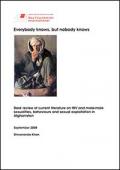
Resource | Publications,
The objectives of this assessment include:
1. To describe the characteristics of MSM with particular attention to adolescent and young males within community, entertainment, and congregate settings in Kabul, Kandahar, and Mazari-sharif as it pertains to HIV prevention.
2. To assess the circumstances of child abuse/exploitation within the context of MSM within communities, entertainment, and congregate settings in Kabul, Kandahar, and Mazar.
3. To strengthen the knowledge base for the HIV national response for MSM and child abuse/exploitation among the government, donors, and NGOs.
4. To make recommendations for a stronger capacity among the government, donors, and NGOs for appropriate service delivery on HIV prevention, care and support for MSM and children at risk of child abuse/exploitation.
5. To review the development of MSM community-based self-help and other appropriate approaches to HIV prevention, to reduce stigma and discrimination, and to reduce violence against children.
This desk review of current literature on male-male sexualities, behaviours and sexual exploitation in Afghanistan is a part of the rapid assessment of male vulnerabilities to HIV and sexual exploitation in Afghanistan.





